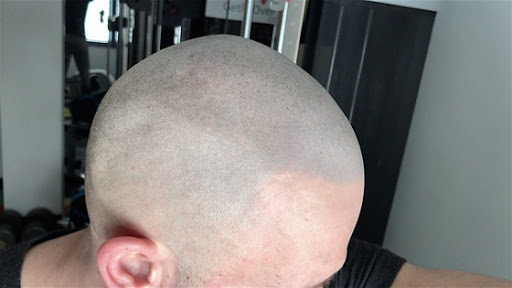
Hair loss is a common problem resulting from both the disease and the body’s natural aging processes. It affects millions of people across the world, including many CrossFitters. People with alopecia experience lower self-esteem, poorly evaluate the quality of life and perceive their body as unattractive. They often develop depression and anxiety disorders. Individuals suffering from hair loss feel the repercussions both in their personal and professional lives. It is not uncommon to seek treatment, including pharmacotherapy and psychological help.
Scalp Micropigmentation, or SMP, is a versatile treatment designed for all people battling hair loss. But before we jump into the dynamics of the procedure, let’s take a closer look at our hair.
Hair, a natural ornament – how important is it for mental health?
Biologically speaking, while our hair no longer plays any significant role, its psychological importance is very high. Hair is an integral part of our image, and therefore also of our identity. Any undesirable change in this area evokes emotions. The loss of eyebrows and eyelashes is of particular importance for self-image changes, being extremely difficult to accept. The experience of baldness causes significant psychological damage, is associated with intense emotional suffering, and leads to interpersonal relationship problems. The quality of life of people who, apart from hair loss, also suffer from mental disorders is even lower.
Undervalued self-esteem is more common and intensified in women. It is directly related to the prevalence of male pattern baldness. What follows is the social perception of such an image – greater acceptance and recognition of baldness as a norm occurs precisely among men. In addition, women’s attractiveness is more closely related to appearance. Lush hair is an essential part of female sexuality. This concern is also a culturally conditioned, stronger focus on physical aspects in the perception of women. In some studies, hair loss is described as more difficult for women to accept than breast loss due to mastectomy. Studies show that about 40% of women with alopecia experience marital problems, and about 63% report nano-negative consequences in their working life.
Hair Loss Causes
Alopecia is the most unpleasant experience of all hair problems. The causes of hair loss are somatic diseases of various reasons, deficiencies related to improper diet, mental disorders, physical factors (burns, mechanical damage), side effects of treatment, such as chemotherapy used in the fight against cancer, and genetic determinants.
Regardless of the pathogenic factors, the causal treatment of alopecia is difficult and often ineffective, which negatively affects patients’ mental states. Even in those cases where the loss of hair is temporary, severe difficulties in coping with the new situation and even mental disorders may occur. So, what causes hair loss?
- Malnutrition, including deficiencies of micro and macro elements, such as iron or zinc;
- Hormonal disorders, such as hyper- and hypothyroidism, an excessive amount of androgens causing androgenic alopecia, decrease in estrogen levels, specifically after menopause;
- Mycosis of the scalp, seborrheic dermatitis;
- Alopecia areata – an autoimmune disease in which the body attacks itself;
- Systemic lupus erythematosus;
- Androgenic alopecia – hereditary alopecia affecting both women and men;
- Drugs, especially those used in cancer chemotherapy (temporary loss), but also contraceptives and anticoagulants;
- Poisoning with heavy metals, such as arsenic, thallium, or mercury;
- Radical diet and heavy weight-loss;
- Frequent hair dyeing and the use of strong hairstyling cosmetics;
- trichotillomania, a disorder characterized by unconsciously pulling hair;
- Lack of adequate protein in the diet;
- Childbirth – hair loss after childbirth is associated with a decrease in the levels of estrogen;
- Excessive vitamin A intake through nutrition and medication;
- Smoking – causes damage and dullness;
- Anorexia and bulimia.
Despite medical advances, alopecia is still a big problem. The supplements and cosmetic preparations themselves usually do not bring the expected results. Hair transplants are often high-risk and costly. Scalp Micropigmentation is a method that allows you to camouflage problems related to alopecia in a safe, predictable, and relatively inexpensive way.
What is SMP
Scalp Micropigmentation consists of introducing the pigment into the deepest layer of the epidermis with a single thin needle. Its use enables complete control over the depth of the dye insertion and precise shaping.
Correctly performed SMP is a safe method of alleviating the adverse effects of alopecia, as it allows absolute control over the quality of the pigment in the skin. It does not change color and fades after some time, which at first glance may seem like a disadvantage. However, let us pay attention to the fact that the balding scalp has a tendency to further baldness, and from time to time, you should perform additional pigmentation treatments for subsequent balding spots. Remember that each pigment becomes lighter over time, and it would be difficult to obtain the same pigmentation effect with each successive treatment. Moreover, the scalp changes its structure with age, the hairline transitions, and it is advisable to correct the hairstyle’s shape. Placing the pigment in the epidermis instead of the dermis, as in traditional tattoo, is the most careful and rational choice. The possibility of reassessing the effect every four or six years – the typical frequency of touch-ups – makes the method an ideal solution.
Cons of SMP
According to a study done by Medihair – unlike hair transplantation, the effect is temporary, and treated skin often looks unnatural when patients vary from the original hairstyle.
Who is a candidate
Anyone, regardless of age or sex, dissatisfied with the amount of hair on their heads is the right candidate for the procedure. If you are struggling with the below conditions, you might want to consider SMP:
- androgenic alopecia,
- partial or complete alopecia areata,
- hair thinning,
- as a supplement after hair transplant,
- masking scars on the head.
SMP for Women
At first glance, it may seem that hair loss exclusively belongs to the male department. Unfortunately, the problem affects all people, regardless of their biological gender. And while it is much easier to determine the cause of hair loss in men, women battling alopecia have a more challenging time figuring out why they are losing their precious strands. Some of the reasons include depression, pregnancy, thyroid dysfunction, or excess vitamin A. Hair loss is a natural occurrence, but only up to a certain point.
Your hair life cycle consists of three phases: the growth phase (anagen), transitional phase (catagen), and resting phase (telogen). If everything is functioning correctly, about ten percent of our hair is in the transition and resting phase, while the remaining ninety percent continues in the growth phase. The alarming red flags begin to flash in front of our eyes when we start to lose growing hair. We may notice hair thinning and scalp showing. If you are suffering from similar ailments, SMP may be the right option for you.
Scalp Micropigmentation reduces the contrast between the skin and hair. The introduced pigment gradually darkens the scalp, optically adding volume so you can regain your confidence and beautiful lush hairstyle. After SMP, you can play with your hair as you wish and visit your favorite hairstylist for a metamorphosis.
Types of SMP
While a skilled SMP practitioner can work his or her magic in a creative and aesthetically-pleasing way, there are some standard types of treatment that you may find suitable:
Receding hairline
Scalp Micropigmentation is a perfect option for anyone struggling with the receding hairline by adjusting its position through careful lowering and restoring the deficits. Your fresh new look is just a step away.
Hair density
Scalp Micropigmentation can add volume and optical density for both men and women with longer hair. Masking hair deficits by filling in the missing or thinning hair through precise pigmentation will imitate growing hair follicles. A talented practitioner with bits of artistic IQ can effectively create a three-dimensional effect by utilizing high-tech equipment explicitly designed for SMP procedures. Unlike some failed transplants or strange-looking wigs, the final outcome will provide a densely crafted natural hairstyle.
Edge-Up “Jamie Foxx”
One of the most popular masculine hairstyles with a gentle and well-defined hairline is the Edge-Up look, paying tribute to Jamie Foxx. The style covers part of the temples and naturally restores a perfectly shaped hairline.
The procedure
Scalp Micropigmentation is a procedure where all the details matter. The process of creating the hair illusion is meticulously crafted in great perfection using hair follicle simulations. To ensure the best results, we recommend performing an average of four treatment sessions. The patient progressively gains more dots on the head during subsequent appointments, resembling a short haircut or volumized lush hairstyle. The amount of sessions is arranged individually depending on the progression of your hair loss.
Every treatment begins with a detailed consultation, so it is essential to ask all the questions you might have about the procedure and communicate your expectations to the artist. Together, you will agree on the best approach to get the most out of your experience, including the pigment color and hairstyle suitable for you.
During the first treatment, your scalp will be prepared to lay the basis for your fresh look. You may experience slight redness at the site of pigmentation, which usually resolves within the next few days. The consecutive treatments consist of filling in more pigments with various shades to obtain the natural-looking effect.
Effects of Scalp Micropigmentation
The effects of Scalp Micropigmentation mask the occurrence of both alopecia areata and androgenic hair loss by creating a perfect imitation of the appearance of your hair. After the treatment, patients get the result of a shortcut in men and optical thickening of sparse hair in women. SMP is also an ideal option for camouflaging all kinds of scars, lesions, and deficiencies on the head. Being versatile, the treatment can solve multiple problems during one session; for instance, hide the scar after cutting the strap for transplant and thicken the hair simultaneously.
Is SMP safe?
Scalp Micropigmentation is a non-invasive and hence safe method of hair restoration. At professional and licensed clinics, you will find specialized equipment and natural pigments that are introduced to your scalp and pose no risks of infections and other complications. Everything is done in a sterile and safe environment.
Beware of beauty salons or tattoo studios, in which inexperienced staff tries to imitate SMP treatments using an improper technique and pigments intended for traditional tattoos or permanent makeup. The procedure will be deemed unsuccessful with various adverse effects, not only of aesthetic nature. The introduced pigment may change its color over time, while the dots, which are to mimic the follicles, can be more prominent and look unrealistic. Increasingly more people come to our clinic seeking help in improving the effects of an unsuccessful Scalp Micropigmentation. Unfortunately, it may be necessary to remove poorly done SMP and perform it again, which translates into additional costs. We encourage you to evaluate the results of treatments offered by various clinics objectively.
Aftercare
After the procedure, we can feel not so much fatigue as simple weariness. Nothing tires us out more than doing nothing for an extended period of time. When the entire head is subjected to Micropigmentation, the procedure may take up to several hours. You can nap during that time.
After the treatment, your head may be irritated, slightly swollen with microtrauma induced by pigment application. Nothing to stress about – it will pass.
There are no special requirements post-procedure; we don’t have to take any particular measures. Avoid washing your head for the first three days after SMP, or use only water without any shampoos or soaps. Water is good enough to protect your head against dirt. Let the pigment settle under the epidermis. For the first few days, or until your scalp has completely healed, avoid any activity that may cause sweating. Sweat is an excellent breeding ground for bacteria – not our ally on an irritated scalp. Postpone any gym activities, intense exercise, sun, or other exposures to places endangered by fungi, mold, or bacteria, including sauna or swimming pool. Also, it is crucial to protect your head against cold temperatures.
All in all, there is really nothing to fear. Now it’s time to enjoy a new quality of life. Seize these moments and celebrate!

















Follow Us